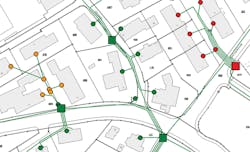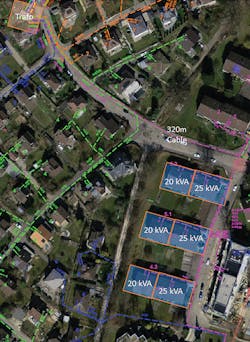During the last century, renewable energy was an important source of power for Switzerland because of its hydroelectric resources. However, it has been difficult to get additional generation capacity in the form of wind and solar power installed because of their adverse impact on the Swiss landscape. The main driver of new renewable energy sources in the country has been solar panels installed on rooftops. With the support of the Swiss government, the number of installations has grown exponentially since 2011. The installed capacity of distributed energy resources in 2015 included 60 MW of wind power and 1394 MW of solar power. By the end of 2016, these figures had increased to 75 MW and 1644 MW, respectively.
As almost all the photovoltaic (PV) rooftop installations are connected to the low-voltage network, distributed network operators (DSOs) need to invest in network upgrades regularly. This is a capital-intensive exercise because of the rural topology of the Swiss low-voltage networks, which consist of long low-voltage feeders supplying a low number of customers with high PV potential. Currently, DSOs analyze each new PV connection request individually and determine whether a network upgrade is required. If an upgrade is required, the DSO must select the most affordable solution.
The solution is proposed by the regulator and ensures customers can install their PV systems at the lowest cost. Any network reinforcement costs are socialized nationally by being included in the energy tariff. Unfortunately, the selection process does not consider potential future PV systems neighboring customers might install on the same low-voltage feeder. Therefore, the most affordable solution for a given customer may not be the best investment in the long run if additional PVs are installed in later years on the same low-voltage feeder.
The Prosumer Challenge
In the last few years, because of the attractiveness of feed-in tariffs, domestic prosumers have installed as much solar power as possible to inject maximum renewable energy into the low-voltage network. However, during that time, feed-in tariffs for solar panel systems have been reduced or discontinued.
Now the PV business model must move from focusing on injecting as much energy as possible into the network to focusing on a new model that increases the self-consumption rate as the most important economic driver. An optimal balance must be reached among installation costs, generated energy and self-consumption to reduce the need for investment and optimize the prosumer’s energy consumption.
Utility-Scale Solar
A common solution is needed that helps DSOs and prosumers to reduce network investments while increasing the profitability of residential PV installations. The utility-scale domestic solar (USCADOS) concept — a pilot project developed by BKW Energie AG — provides an innovative approach to this challenge. At the core of the concept is the proactive role of DSOs in the transition of the Swiss energy system.
USCADOS enables the DSO to identify maximum potentials and optimal PV configurations for an entire regional low-voltage network, assisting customers in achieving maximum individual profitability. Through this proactive role, the DSO can minimize low-voltage network upgrade costs while enabling customers to achieve higher profitability by allowing the installation of higher-capacity PV installations. The USCADOS concept is composed of three main algorithm steps: network calculation, customer profitability and system optimization.
Network Calculation
The first step of USCADOS is an automated network analysis once the network input date is in place. Then the low-voltage network is compared to the potential future PV installations to identify the possible network constraints based on the regulator’s recommendations. This analysis includes a load-flow calculation to determine the voltages and currents on the entire low-voltage network, based on the renewable power injections.
This calculation is an implementation of two scenarios:
• Maximum individual injection. The maximum PV energy injection for each building is calculated, based on the actual state of the network. This information is valuable for the DSOs because they can improve their network planning and share with the prosumers the maximum PV capacity installation that would not require network reinforcement.
• Network constraints for maximum PV potential. Each network is analyzed to consider the maximum PV installed capacity for each building with high solar potential. These results enable DSOs to identify which networks would require an upgrade and which networks are sufficient for the installation of all the potential PVs without further investment. It also enables the evaluation of smart grid solutions, such as voltage regulators or reactive power control.
Customer Profitability
Once the network constraints are identified, the second step is a profitability analysis for each building. To evaluate profitability, it is necessary to estimate accurately the PV costs, annual energy output that could be injected into the low-voltage network and annual self-consumed energy. Because profitability is based mainly on the self-consumption rate, total solar production and various tariff options, there is a high potential to optimize the system so profitability is maximized.
The interaction between prosumers and DSOs is not optimal. In Switzerland, it is mandatory for the DSO to provide the prosumer with the network costs associated with each new solar power installation; the prosumer does not receive information linked to maximizing the profitability of the new installation. The USCADOS concept aims to give prosumers additional information and support; to date, this has received positive feedback from prosumers.
System Optimization
System optimization is the third step of USCADOS. Solar planners in Switzerland design solar installations with the output power of the PV modules being the same as the inverter power. Following the development and applications of this design tool, it is acknowledged the correct design of the inverter plays a key role in the profitability of the solar system.
Because of the geographic location of Switzerland, power generated by PV panels rarely reaches the nominal power. Because the DSO designs the low-voltage network based on the worst case, a smaller inverter could avoid network reinforcement without leading to high amounts of energy loss. Alternatively, the resulting losses would not have an impact on the self-consumption rate because, in periods of high solar irradiation, the production always would be higher than the consumption, and this surplus energy would be injected into the low-voltage network.
As the business moves into the self-consumption direction, optimal planning will lead predominately to larger direct-current (DC) installations rather than larger alternating-current (AC) power components; therefore, it will increase energy production without injecting new peaks into the network. This design tool implements a function that can identify the optimal inverter size for each PV installation under consideration.
Module Optimization
The prosumer should be able to design their installation with the goal of maximizing the self-consumption rate. The USCADOS tool analyzes profitability by considering different solar modules and inverter sizes as well as related network reinforcement costs. The process continues until the maximum profitability is identified, with the optimal number of PV modules and the inverter size specified for each building. In many cases, the optimal design of the inverter size and PV module system avoids any network reinforcement, increasing profitability of the installation.
Analyzing Results
The USCADOS tool has been implemented as a service for various municipalities where all the analyzing design studies have been implemented. The profitability for each customer with high solar potential has been calculated using the customer profitability module. However, because of the high installation costs in Switzerland, more than 70% of customers would have a negative profitability if they decided to maximize the PV installation by covering their roofs with solar panels.
The optimization module has been implemented to evaluate the impact of an improved installation design on customer profitability. The results for the same municipality show an additional 20% of customers would achieve positive profitability because of the optimization calculations.
In addition, the network analysis also shows no network upgrade modifications would be required if the customers install an optimized PV installation instead of the maximum. This results in a reduction in network costs and an increase in the self-consumption of the municipality. Alternatively, a reduction in the installed PV power per roof also could limit total PV generation in the future. To reduce this impact, new potential applications, such as batteries or flexible loads, are being evaluated.
Potential Applications
The profitability and optimization algorithms are the foundation for additional applications:
• Managing heat systems. In Switzerland, around 10% of the total electric consumption is linked to thermal systems, including electro-boilers and heat pumps. As a result, these loads can be controlled to coincide with the period of high solar generation. In USCADOS modeling scenarios with PVs and heat systems, it has been shown self-consumption and self-autonomy would increase, enabling the installation of a higher number of solar panels on each roof with a positive profitability.
• Batteries. As the cost of storage batteries continues to decrease, their potential for increased self-consumption and profitability increases. Because of their relative high cost, it is necessary to define the optimal size of the battery. During 2017, it was proven that solar projects that had a storage battery installed increased customer profitability. Therefore, a battery package will be included in the system optimization module on the USCADOS tool, where the optimal battery capacity size will be calculated for each building.
• Other flexible loads. Additional electrical applications, such as electric vehicles, also could help to increase the profitability of solar systems. Charging an electric vehicle is an additional load, but it can act as an electric battery and increase the customer’s self-consumption. To evaluate this potential functionality, a further analysis of electric vehicle behavior is required.
As can be seen from these three potential applications, the penetration of new components will enable optimal self-consumption and autonomy levels to be reached with an increase in the number of solar panels. Thus, by including these applications, the installation of additional PV panels will be supported, which, in turn, would increase the total PV generation output. Currently, the USCADOS concept is being promoted and marketed as a solar park for municipalities, providing a service to both municipalities and smaller DSOs.
Addressing Challenges
The USCADOS concept is a novel, proactive approach that addresses a whole set of challenges DSOs and prosumers currently face in Switzerland. The concept permits a higher penetration of PV systems with a higher profitability while reducing the required network upgrade costs. To reach the goals set by the European Union and Swiss government, DSOs and prosumers should work together to face their challenges and contribute to the required energy transition. BKW also is seeking to establish closer collaboration with planning authorities and builders to promote the inclusion of solar modules in new buildings.
The tool BKW plans to extend will include the analysis method into the planning and realization process for mid- and large-scale projects involving many commercial and industrial buildings. Developers and investors of such projects will be additional target groups for the team, which is actively looking for new projects and partners. ♦
Yamshid Farhat holds a MSEE degree from the Polytechnic University of Catalonia and did work for his master’s thesis at Aalborg University in the field of microgrids. He joined BKW Energie AG’s smart grid engineering department in 2013 and has responsibility for developing innovative products and concepts for the distribution network.
Martin Bolliger received a master’s degree in energy systems from the Institute of Geography at the University of Berne in Switzerland in 1999. Since then, he has been working in the renewable energy sector and is a cofounder of Swiss Clean Drive Ltd. Bolliger has been a senior project manager in the BKW Technology Center at BKW Energie AG since 2014.
Check out the May 2018 issue for more articles, news and commentary.









